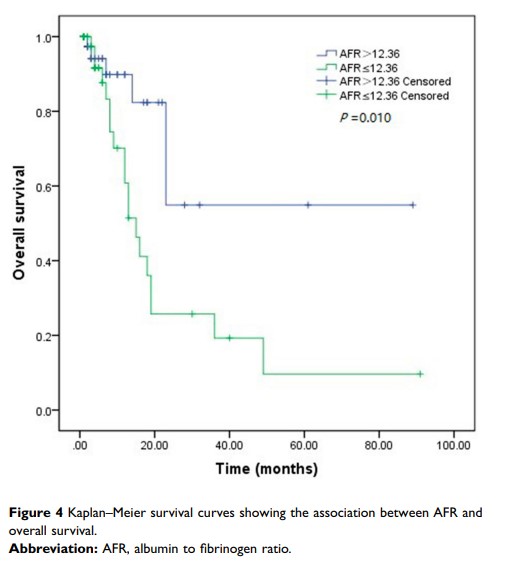9 0 8 0 2
论文已发表
注册即可获取德孚的最新动态
IF 收录期刊
- 2.6 Breast Cancer (Dove Med Press)
- 3.9 Clin Epidemiol
- 3.3 Cancer Manag Res
- 3.9 Infect Drug Resist
- 3.6 Clin Interv Aging
- 4.8 Drug Des Dev Ther
- 2.8 Int J Chronic Obstr
- 8.0 Int J Nanomed
- 2.3 Int J Women's Health
- 3.2 Neuropsych Dis Treat
- 4.0 OncoTargets Ther
- 2.2 Patient Prefer Adher
- 2.8 Ther Clin Risk Manag
- 2.7 J Pain Res
- 3.3 Diabet Metab Synd Ob
- 4.3 Psychol Res Behav Ma
- 3.4 Nat Sci Sleep
- 1.9 Pharmgenomics Pers Med
- 3.5 Risk Manag Healthc Policy
- 4.5 J Inflamm Res
- 2.3 Int J Gen Med
- 4.1 J Hepatocell Carcinoma
- 3.2 J Asthma Allergy
- 2.3 Clin Cosmet Investig Dermatol
- 3.3 J Multidiscip Healthc

低白蛋白/纤维蛋白原之比可预测食管小细胞癌患者较低的整体生存率:一项回顾性研究
Authors Wang Y, Li J, Chang S, Zhou K, Che G
Received 18 February 2020
Accepted for publication 30 March 2020
Published 21 April 2020 Volume 2020:12 Pages 2675—2683
DOI https://doi.org/10.2147/CMAR.S250293
Checked for plagiarism Yes
Review by Single-blind
Peer reviewer comments 2
Editor who approved publication: Professor Rudolph Navari
Purpose: To explore the prognostic value of albumin to fibrinogen ratio (AFR) in patients with esophageal small cell carcinoma (ESCC).
Patients and Methods: Patients diagnosed with ESCC in West China Hospital from June 1, 2010, to July 31, 2019, were retrospectively reviewed. The AFR was defined as the ratio between the serum albumin level and fibrinogen level. The receiver operating characteristic curves were conducted to determine optimal cut-off values for survival prediction. Univariate and multivariate cox regression analyses were performed to clarify independent prognostic risk factors.
Results: A total of 88 ESCC patients were enrolled in our study with the median follow-up time of 6 months (range 1– 91 months). In the univariate analysis, the node metastasis, extraesophageal metastasis status, tumor-node-metastasis (TNM) stage and AFR were found to be potentially related with overall survival (OS) of ESCC patients. After the multivariate analysis, AFR [hazard ratio (HR)=3.487, 95% confidence interval (CI): 1.179– 10.312; P =0.024] and TNM stage (HR=6.044, 95% CI: 1.045– 34.974; P =0.045) were testified to be independent prognostic factors and low AFR (≤ 12.36) level was significantly associated with poor OS in ESCC patients.
Conclusion: The current study reported that AFR could serve as a novel prognostic indicator in ESCC and patients with AFR≤ 12.36 were more likely to have poor prognosis.
Keywords: albumin to fibrinogen ratio, esophageal small cell carcinoma, overall survival
